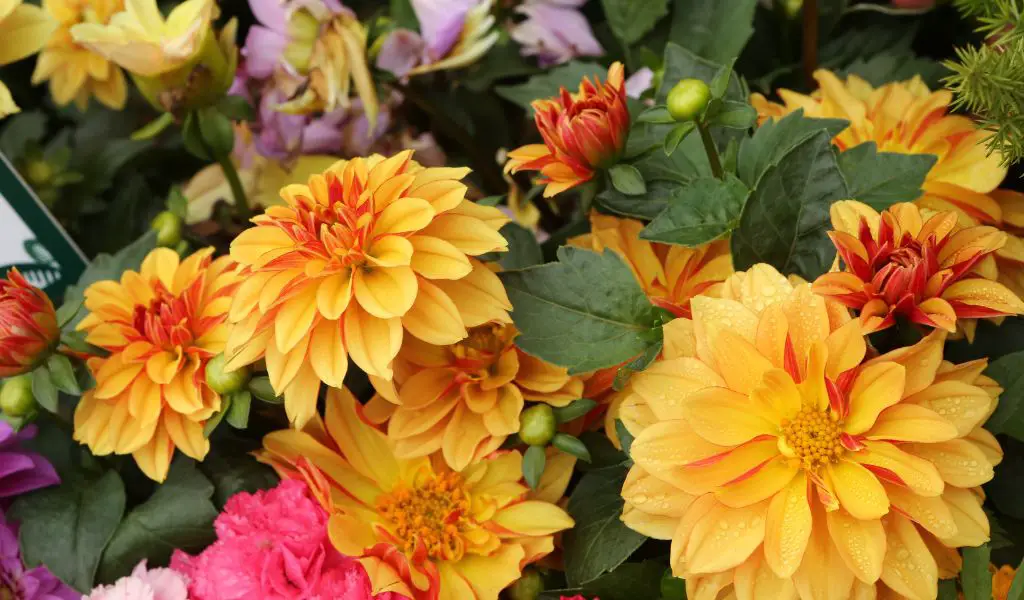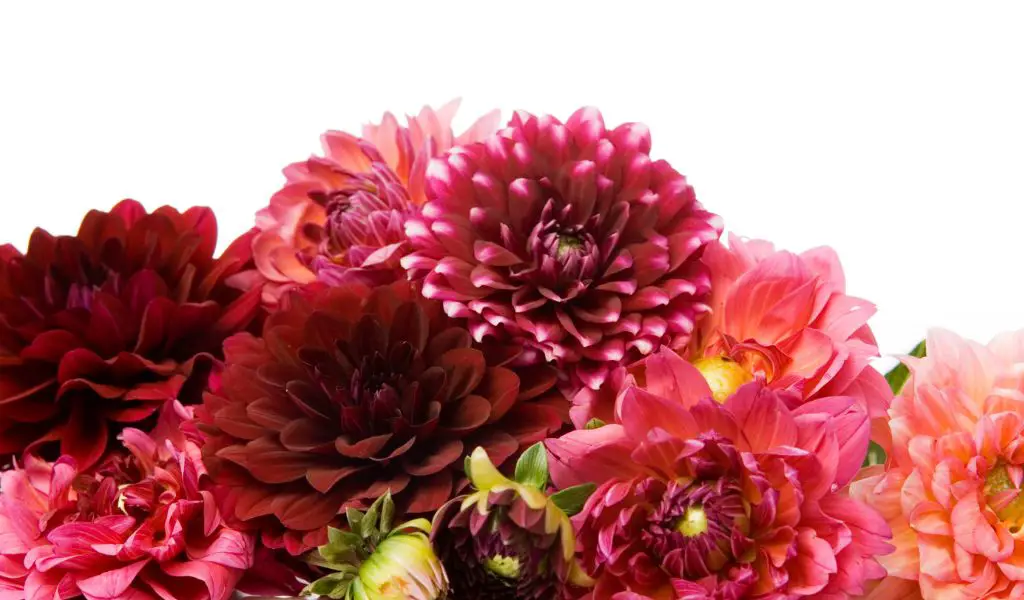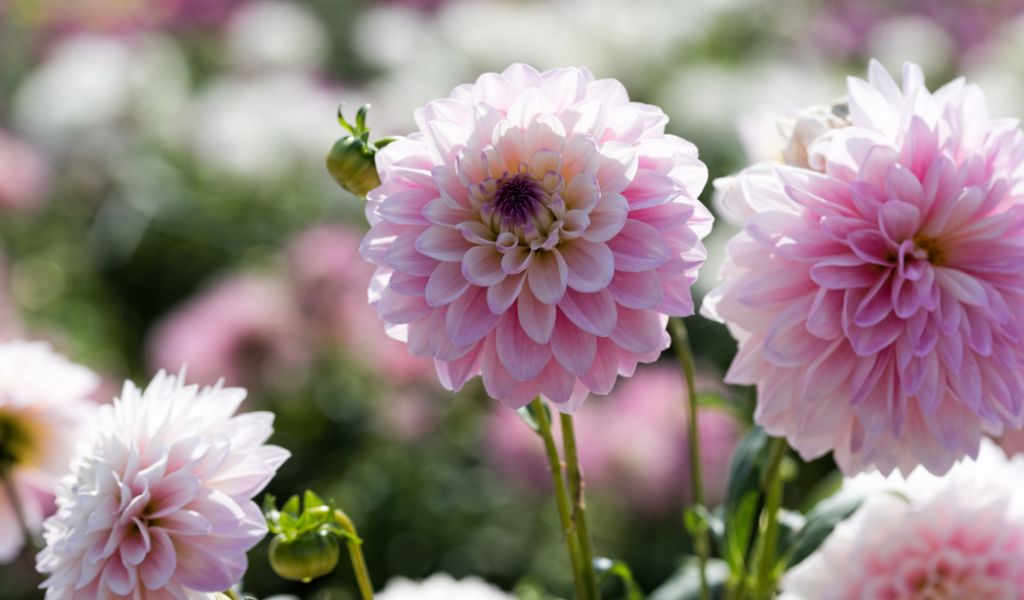Dahlias are stunning, versatile flowers that can be the centerpiece of any garden. With their wide range of sizes, colors, and shapes, there’s a dahlia variety for everyone.
In this article, we’ll explore how to grow dahlias, from choosing the right variety to planting, caring for, and overwintering these beautiful blooms. Let’s dive in!
Choosing the Right Dahlia Variety
Types of Dahlias
Dahlias come in numerous types, each with its own unique characteristics. Some common types include:
Single-flowered dahlias
Anemone-flowered dahlias
Waterlily dahlias
Decorative dahlias
Cactus and semi-cactus dahlias
Consider factors like size, bloom time, and intended use (such as cutting or garden display) when selecting a variety.
Color Selection
Dahlias are available in a rainbow of colors, from soft pastels to bold, vibrant hues. Choose colors that complement your garden’s existing palette or create a striking contrast for visual interest.










Planting Dahlias
When to Plant
The best time to plant dahlias is in late spring, after the last frost has passed. Soil temperatures should be at least 60°F (15°C) to ensure optimal growth.
Soil Preparation
Dahlias thrive in well-draining, fertile soil with a pH between 6.0 and 7.0.
Amend your soil with organic matter, like compost or well-rotted manure, to improve drainage and fertility. A soil test can help you determine the appropriate amendments and pH adjustments.
Planting Technique
Plant dahlia tubers about 6 inches deep, with the eye facing upwards.
Space the tubers 18 to 24 inches apart, depending on the variety’s size. Cover the tubers with soil, and water thoroughly to encourage root development.
Propagation: Growing Dahlias from Seed and Cuttings
In addition to growing dahlias from tubers, you can also propagate them from seeds or cuttings. Here’s how to get started with each method.
Growing Dahlias from Seed
Start dahlia seeds indoors 6-8 weeks before your last frost date. Fill seed trays or pots with a well-draining, seed-starting mix.
Sow the seeds on the surface of the mix, gently pressing them into the soil. Cover the seeds with a thin layer of soil or vermiculite.
Keep the soil consistently moist and maintain a temperature of 70-75°F (21-24°C). Germination should occur within 7-21 days.
Once the seedlings have developed at least two sets of true leaves, transplant them into larger pots or into your garden, following the planting and care instructions previously discussed.
Growing Dahlias from Cuttings
In late winter or early spring, pot up your stored dahlia tubers in a well-draining potting mix, leaving the eye (growth point) exposed.
Place the potted tubers in a warm, well-lit area and water them sparingly until new shoots emerge.
Once shoots are 3-4 inches long, take a sharp, sterile knife and cut the shoot as close to the tuber as possible, ensuring that at least one leaf node is included in the cutting.
Remove the lower leaves from the cutting and dip the cut end in rooting hormone.
Plant the cutting in a pot filled with moist, well-draining potting mix.
Place the pot in a warm, well-lit area, and maintain high humidity by covering the pot with a plastic bag or placing it in a propagation chamber.
Roots should form within 2-3 weeks.
Once the cutting has developed a healthy root system, transplant it into a larger pot or into your garden, following the planting and care instructions previously discussed.

Dahlia Pests and Diseases
Like any plant, dahlias may encounter pests and diseases. Here are some common issues and how to address them.
Pests
Aphids: These small, sap-sucking insects can cause distorted growth and transmit diseases. Control aphids with insecticidal soap, neem oil, or by releasing beneficial insects like ladybugs.
Slugs and snails: These pests feed on the foliage and flowers of dahlias. Use slug and snail baits, barriers, or handpick them during evening hours.
Diseases
Powdery mildew: This fungal disease appears as a white, powdery substance on leaves and can lead to leaf distortion and defoliation.
Ensure proper air circulation, avoid overhead watering, and use fungicides if necessary.
Botrytis blight: This gray, fuzzy mold affects dahlia flowers and leaves. Remove and discard infected plant material, improve air circulation, and use fungicides if the problem persists.
By keeping an eye out for these issues and addressing them promptly, you can ensure that your dahlias remain healthy and beautiful throughout the growing season.
Companion Planting with Dahlias
Companion planting is the practice of growing plants together that benefit each other in some way.
Dahlias can benefit from the presence of certain plants and also provide benefits to their neighbors.
Here are some plants that make great companions for dahlias:
Marigolds: These vibrant flowers not only add color to your garden but also deter pests like aphids and nematodes.
Plant marigolds near your dahlias to create a natural pest barrier.
Nasturtiums: Nasturtiums attract beneficial insects and help repel pests like aphids.
Their bright blooms also complement dahlia flowers nicely.
Herbs: Many herbs, such as basil, chives, and mint, help deter pests and can also be used as a natural pest control method.
Plant these herbs near your dahlias to create a fragrant and pest-free garden.
Grasses: Ornamental grasses can provide a lovely contrast to the bold shapes and colors of dahlias.
They also help to anchor the soil, preventing erosion around the dahlia’s shallow root system.
Foliage plants: Plants with interesting foliage, such as heucheras, hostas, and ferns, can add texture and contrast to your dahlia garden, enhancing the overall visual appeal.
By incorporating these companion plants into your garden, you can create a more diverse, attractive, and healthy environment for your dahlias to thrive in.
Dahlias as Cut Flowers
Dahlias make excellent cut flowers, thanks to their long-lasting blooms and stunning variety.
To create beautiful, long-lasting dahlia arrangements, follow these tips:
Cut flowers in the morning: Dahlias are best cut early in the morning when they are fully hydrated.
Choose flowers that are almost fully open, as they will continue to open slightly after being cut.

Use sharp, clean tools: To prevent damage and minimize the risk of spreading disease, always use clean, sharp tools when cutting dahlias.
Condition the flowers: Immediately after cutting, place the stems in warm water and let them rest for a few hours.
This process, called conditioning, helps to prolong the vase life of your dahlias.
Change the water regularly: Replace the water in your vase every couple of days to prevent bacterial growth and extend the life of your arrangement. Adding a floral preservative can also help.
With their captivating colors and shapes, dahlias can elevate any floral arrangement, making them a popular choice for both home gardeners and professional florists alike.
Using Dahlias in Your Landscape Design
Dahlias can be used in various ways to enhance your garden’s overall design.
Here are some ideas for incorporating dahlias into your landscape:
Mixed borders: Dahlias can be combined with other flowering plants, grasses, and foliage plants to create dynamic, visually interesting mixed borders.
Cutting gardens: Create a dedicated cutting garden by planting dahlias alongside other cut flower favorites like zinnias, cosmos, and sunflowers.
Mass plantings: For a bold statement, plant dahlias in large drifts or groups, creating a stunning display of color and texture.
Container gardens: Smaller dahlia varieties can be grown in containers, allowing you to enjoy their beauty on patios, balconies, or other small spaces.
By experimenting with different dahlia varieties and garden placements, you can create a unique and captivating garden design that showcases these magnificent flowers.
Caring for Dahlias
Watering
Dahlias require consistent moisture, especially during the growing season.
Water your dahlias deeply and regularly, aiming for 1-2 inches of water per week. Avoid overhead watering, which can lead to disease.
Fertilizing
Apply a balanced, slow-release fertilizer at planting time, and supplement with liquid fertilizer every 3-4 weeks throughout the growing season.
Avoid high-nitrogen fertilizers, as they can encourage excessive foliage growth at the expense of blooms.
Staking
Tall dahlia varieties and those with large blooms may require staking for support.
Deadheading
Regularly remove spent blooms to encourage continuous flowering and maintain a tidy appearance.
Deadheading also helps direct energy to new blooms and prevents seed formation, which can weaken the plant.
Overwintering Dahlias
In colder climates, dahlias may not survive the winter, so it’s essential to overwinter them properly.
Digging Up the Tubers
After the first frost, cut back the dahlia stems to about 6 inches above the ground.
Carefully dig up the tubers, being cautious not to damage them. Gently remove excess soil, and let the tubers dry for a day or two in a well-ventilated area.
Storing the Tubers
Once the tubers are dry, place them in a storage container filled with peat moss, vermiculite, or sawdust.
Store the container in a cool, dark, and well-ventilated location with a temperature between 40-50°F (4-10°C).
Check the tubers periodically for signs of rot or desiccation, and discard any damaged tubers.
Conclusion and final thoughts 💭
Growing dahlias can be a rewarding experience, as these captivating flowers provide an abundance of color and beauty in your garden.
By following the tips outlined in this article, you’ll be well on your way to cultivating healthy, vibrant dahlias that will be the envy of your neighborhood. Happy gardening!
FAQs
Q1: Can I grow dahlias in pots?
Yes, you can grow dahlias in pots, but make sure to choose a large enough container and a dwarf or compact variety that is better suited for container gardening.
Q2: How often should I deadhead my dahlias?
Deadhead your dahlias as needed, typically every few days or weekly, depending on the variety and the number of blooms.
Q3: Are dahlias deer resistant?
Dahlias are not considered deer resistant. In areas with deer populations, you may need to take extra precautions like using deer repellents or fencing to protect your plants.
Q4: How long do dahlia blooms last?
Individual dahlia blooms typically last 5-10 days. However, with proper care and deadheading, dahlias can provide continuous blooms from mid-summer through the first frost.
Q5: Do dahlias attract bees and butterflies?
Yes, dahlias attract a variety of pollinators, including bees and butterflies, making them an excellent addition to a pollinator-friendly garden.




